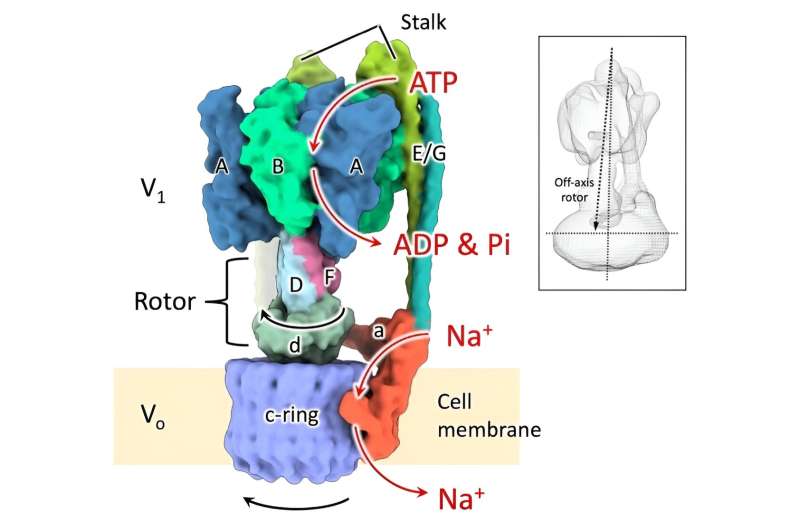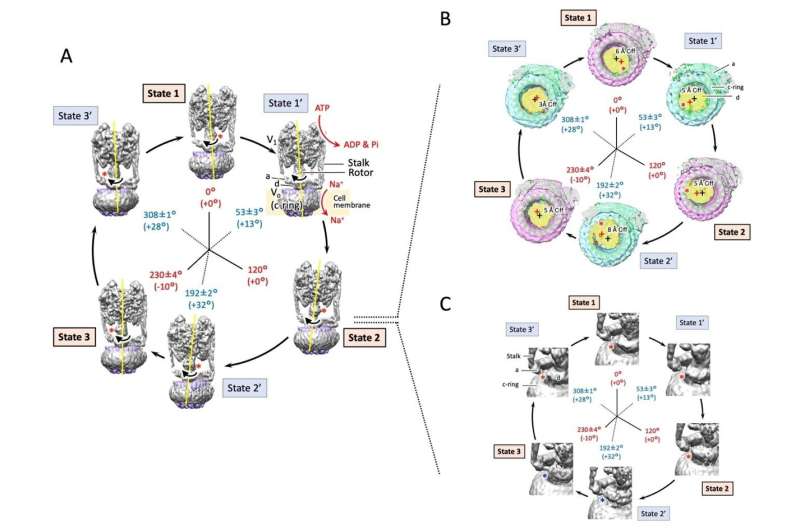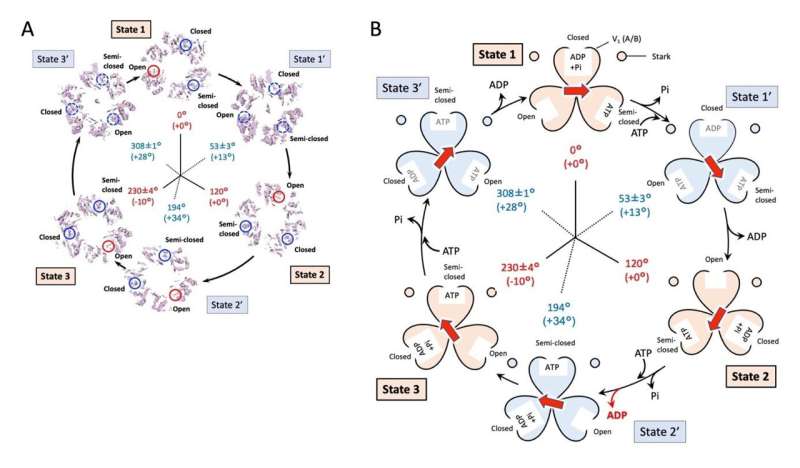This article has been reviewed according to Science X's editorial process and policies. Editors have highlighted the following attributes while ensuring the content's credibility:
fact-checked
peer-reviewed publication
trusted source
proofread
Study reveals structures of six states of a rotary sodium ion pump

Six structures exhibited by the rotating sodium ion pump were reconstructed in 3D using cryo-electron microscopy. This analysis revealed that the rotor exhibits non-uniform rotation behavior due to partial structural interference with the stator component, and the rotor interacts with one edge of the large ion transport ring causing it to rotate. The study showed a unique molecular mechanism of the rotary sodium ion pump.
The results are published in Communications Biology.
"In previous single-molecule imaging experiments, it was predicted that the three main pausing points of the rotor would be 120 degrees apart, and each sub-pause would be 40 degrees ahead (80 degrees back) from each main pause, but there was no structural evidence," said corresponding author Kazuyoshi Murata, project professor, Exploratory Research Center on Life and Living Systems (ExCELLS) and National Institute for Physiological Sciences (NIPS) in Japan.
"It was also a mystery how the thin shaft (rotor) that connects the power unit rotates the sodium ion transport ring, which is larger than this unit. The rotor turns the large ion transport ring as if it were stirring with uneven rotation behavior."
EhV-ATPase background
Almost all living organisms, from bacteria to humans, have the rotary enzyme ATP synthase in their cell membranes. These all have a similar structure in which an extramembrane part for decomposing or synthesizing the compound ATP and an intramembrane part for passing ions across the membrane are connected by a thin shaft (rotor) to provide dual functionality. ATP synthase can use both the energy of the passive flow of ions across the membrane to synthesize ATP, while ions can be actively transported across the membrane by decomposing ATP.
The rotary sodium ion pump (EhV-ATPase) of Enterococcus hirae decomposes ATP in the extramembrane power unit (V1) and rotates the rotor at its center, which rotates the sodium ion transport ring (c-ring) of the intramembrane pump unit (Vo).
This transports sodium ions from the inside to the outside of the cell. The power unit consists of three symmetrically arranged ATP degradation domains (consisting of an A/B heterodimer), which are known to rotate the rotor by 120 degrees through sequential degradation of ATP. The research group previously labeled this power unit with a gold nanoparticle and performed single-molecule imaging experiments, and found that sub-pauses (State 1' to 3') exist at each position 40 degrees ahead (80 degrees back) of the main pauses (State 1 to 3), and identified six "pause" states.
Also, EhV-ATPase has a large c-ring, like V-ATPase in higher organisms, but there is no other protein subunit that connects the rotator straight to the center of the c-ring, as seen in higher organisms. Therefore, in EhV-ATPase, what the six structures including the sub-pause are and how the rotator rotates the large c-ring remained a mystery.

Research results
In this study, in order to answer these questions, the team induced rotation by adding ATP and sodium ions to detergent-solubilized EhV-ATPase, rapidly froze the sample, and collected many images using cryo-electron microscopy. After classifying the obtained images and reconstructing them in 3D, they succeeded in reconstructing a total of 6 structures consisted of 3 main pauses and 3 sub-pauses for the first time.
As described earlier, the rotor rotation of EhV-ATPase was supposed to stop at the main pausing points (States 1 to 3) separated 120°. This was true in States 1 and 2, but it was found that there was a -10° deviation in the rotor angle in State 3. In addition, at the sub-pauses (State 1' to 3'), large angle deviations of +13° (State 1'), +32° (State 2'), and +28° (State 3') from those expected were observed.
Then, it was found that the rotor edge deviated from the center of the c-ring and interacted to one edge of the c-ring, causing the c-ring to stir and rotate. This rotational angle deviation is particularly pronounced between States 2 and 3," and it is thought that these are caused by structural interference between the subunit "d" of the rotor edge and the adjacent stator subunit "a".
In the power unit V1, the team was able to partially confirm changes in the bound and decomposed states of ATP during rotational motion. Based on previous studies, it is believed that the three symmetrically arranged ATP binding domains sequentially exhibit three states: "Closed" with ATP bound, "Semi-closed" with ATP decomposed into ADP and phosphate (Pi), and "Open" with no ATP or ADP bound.
By applying these states to the obtained structural map, the team was able to confirm the conformation of the ATP binding structure at the three main pauses. On the other hand, at the three sub-pauses, except for State 2," the researchers obtained structures that are considered to be in a state in which all the ATP binding pockets are filled with ATP or ADP before ADP is released and the domain becomes "Open".
As mentioned above, in State 2, structural interference between the rotor and the stator was thought to cause the ATP binding domain to proceed to the same state as in State 3 and stop.

Significance of results and future perspective
In this study, by actively inducing rotation and by analyzing the structures during rotor rotation, the researchers were able to visualize six structures (three main pauses and three sub-pauses) of EhV-ATPase. This result clarified that the EhV-ATPase transports sodium ions by rotating a large c-ring and revealed that structural interference of the rotor with a part of the stator (subunit "a") caused a deviation in the rotation angle.
These findings suggest an adaptive process from a simple to a more complex structures in the evolution of the nearly ubiquitous rotary ion pumps, and have provided much structural information for the development of inhibitors and functional modification of enzymes. Based on this result, it is expected that drug discovery and development targeting this ion pump will progress greatly in the future.
More information: Kazuyoshi Murata et al, Six states of Enterococcus hirae V-type ATPase reveals non-uniform rotor rotation during turnover, Communications Biology (2023). DOI: 10.1038/s42003-023-05110-8
Journal information: Communications Biology
Provided by National Institutes of Natural Sciences




















